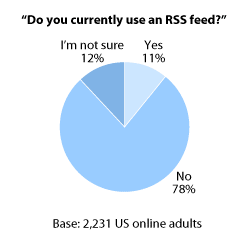Marketers: RSS is DOA in its current design
Steve Rubel points to a report from Forrester that shows an anemic growth of 11% for RSS over the last few years.
The report cites many reasons leading to 41% of users not being sure whether they are interested or not interested (I love that survey response option btw) and 78% of those that know what RSS is, actively choose not to use it. ikes!
So why am I jumping in the middle of this parade? Simply because RSS was bone headedly given consumption status when it should have been confined to the plumbing that no one wants to look at. Max Kalehoff sums it up in a comment really nicely:
Who cares about RSS? It’s only the format in which data travels through the pipeline, to someone who opted in. There’s no reason most people should even care what it stands for. I predict RSS will become huge when, or if, more relevant services adopt it as invisible infrastructure, not as a consumer-facing value proposition.
Marketers: Don’t buy the argument that engaging your prospects and customers via MyYahoo or Microsoft Outlook-enabled RSS will do you any good.
This short lived ray of hope will prove to be less effective than driving traffic to your sites regardless of how expensive the later has become. I used to subscribe to a boatload of print magazines that piled up on my desk and eventually hit the trashcan unread. Too much to sift through. Then came RSS making it ever so simple to subscribe to any number of rags and blogs, all available in one one place, to be read on my terms. The ease of subscription soon made this just as bad as the pile of unread rags on my desk. Opening Google Reader to see the dreaded “1000+” unread items, (including your marketing message) became a daily joy. Sure, MS Outlook, iGoogle & MyYahoo can be useful but respect the mediums limitation and provide pointed feeds based on topics, not source.
On to the solution for marketers:
- Lose the intimidating orange RSS button that takes your prospects and customers to an even more intimidating RSS feed page or as bad, an option to add it to a something called an “RSS Reader”. They haven’t heard of any of those things.
- Let your users opt in to monitor topics and not the fire hose of content from a given source. Think about it -there’s very few instances when you want to know everything someone says. Topics across sources are more important to one’s entertainment, purchasing intentions or news consumption feeds. Your prospects and customers feel the same. There’s a few solutions that help with this. Los Altos, CA based Simplefeed, is one of them.
- Consider putting RSS search results in place on all of your content and allow users to monitor this via known mechanisms such as Email to begin with. Start with something as simple as what firms such as SimplyHired does: Email notifications for search results. Its simple. It covers only what I ask for. I get it pushed to me when there’s new stuff.
- Don’t rely on a Reader to get your message across. I’m biased here but enable consumption that doesn’t require adopting yet another web or client application such as an RSS reader, desktop download or a FireFox plug-in. Email, IM, Mobile Device – have all the distribution muscle you’ll ever need. That’s the way to go.
- Kill the RSS feeds index page. No one goes there. Really. Its a waste of dollars and results in a false hope that people will click on some link hidden in the footer of your site. If you don’t catch the visitor at the point where they saw the interesting product description, press release, a support forum thread, promotion or item for sale, it’s just not going to happen. Enable opt in mechanisms for narrow content topics on relevant pages on your site.
Ive focused on what enterprise marketers should think about. As to overall adoption of RSS, well beyond just blogs and news, Keith Teare and Jeff Nolan (who know a thing or 4 about RSS) dive deeper into the role of RSS behind the scenes and the unaccounted value.

![Reblog this post [with Zemanta]](http://img.zemanta.com/reblog_e.png?x-id=5f8c2d7e-e9aa-4986-bd40-dab1ed5b31a5)
[…] is dead. Not the product but the brand. It’s time to let go of the acronym, stop squabbling and figure out how to translate and […]